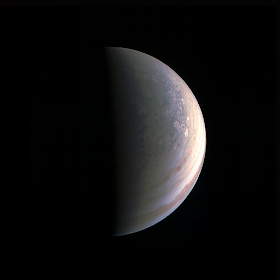Juno's infrared view of the auroras at the Jovian south pole, not visible from earth (27 August 2016). The Image Source: NASA/JPL.
NASA has released more data from Juno's mission to Jupiter over the past week, including a heat vision photograph of the southern lights over the maw that is the planet's south pole. Photographs from 27 August 2016 revealed that the north pole features a sea of giant cyclones. NASA also published an audio recording of Jovian polar aurora activity.
Composite photograph of Jupiter's south pole from Cassini mission (11-12 December 2000). Image Source: NASA/JPL/Space Science Institute.
Jovian north pole: "The JunoCam instrument obtained this view on August 27, about two hours before closest approach, when the spacecraft was 120,000 miles (195,000 kilometers) away from the giant planet (i.e., for Jupiter's center). Unlike the equatorial region's familiar structure of belts and zones, the poles are mottled with rotating storms of various sizes, similar to giant versions of terrestrial hurricanes. Jupiter's poles have not been seen from this perspective since the Pioneer 11 spacecraft flew by the planet in 1974." Image Source: NASA/JPL-Caltech/SwRI/MSSS.
Video Source: NASA via Youtube.
Caption for the above video: "Thirteen hours of radio emissions from Jupiter's intense auroras are presented here, both visually and in sound. The data was collected when the spacecraft made its first orbital pass of the gas giant on Aug 27, 2016, with all spacecraft instruments turned on. The frequency range of these signals is from 7 to 140 kilohertz. Radio astronomers call these 'kilometric emissions' because their wavelengths are about a kilometer long."




No comments:
Post a Comment